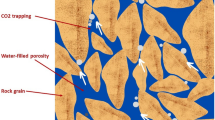Abstract
One way to reduce carbon dioxide (CO2) emissions to the atmosphere is to recover it from an energy conversion process (e.g. from stack gases) and to store it in an aquifer (a permeable, mainly sandy, underground layer). The main goal of this study was a preliminary evaluation of this kind of storage.
Allowing for a large uncertainty in the geological properties, we arrived at the following tentative results. The average cost of disposal is $1.4 per ton CO2 stored. The enclosing layer of most aquifers seems impermeable enough to prevent the CO2 from rising to the surface within at least 10 000 years. The main technical uncertainty is whether the water in the reservoir can be pushed aside fast enough to prevent an intolerable pressure build-up in the reservoir.
The disposal of CO2 in aquifers seems to be a feasible option in the light of existing geological knowledge. If it is a practical possibility, the opportunities are large and the costs appear to be relatively low. However, uncertainties remain in the technical sphere. These uncertainties have to be studied and dispelled before the disposal of CO2 in aquifers can be said to be called technically feasible.
Similar content being viewed by others
References
Blok, K., Hendriks, C. A., and Turkenburg, W. C.: 1989, ‘The Role of Carbon Dioxide Removal in the Reduction of the Greenhouse Effect’, inIEA/OECD Expert Seminar on Energy Technologies for Reducing Emissions of Greenhouse Gases, IEA.
Hendriks, C. A., Blok, K., and Turkenburg, W. C.: 1989, ‘The Recovery of Carbon Dioxide from Power Plants’, inClimate and Energy, Kluwer Academic Publishers, Dordrecht, The Netherlands.
Hendriks, C. A., Blok, K., and Turkenburg, W. C.: 1991, ‘Technology and Cost of Recovering and Storing Carbon Dioxide from an Integrated-Gasifier, Combined-Cycle Plant’,Energy Intern. J. 16 (11/12).
Hendriks, C. A., and Blok, K.: 1989,Utilization Possibilities and Costs of Recovery and Storage of Carbon Dioxide, (in Dutch), Dept. of Science, Technology and Society, University of Utrecht, The Netherlands.
van der Harst, A. C., and van Nieuwland, A. J. F. M.: 1989, ‘Disposal of Carbon Dioxide in Depleted Natural Gas Reservoirs’, inClimate and Energy, Kluwer Academic Publishers, Dordrecht, The Netherlands.
van Engelenburg, B. C. W., and Blok, K.: 1991,Prospects for the Disposal of Carbon Dioxide in Aquifers, Dept. of Science, Technology and Society, University of Utrecht, Rep. No. G-91006.
Mot, E.et al.: 1989,Report on the National Research Programme on Geothermal Energy and Energy Storage, 1975–1984 (NOA-I), (in Dutch), Energy Research Project Management Office (PEO), Apeldoorn, The Netherlands.
RGD (= Geological Survey of the Netherlands): 1982–1987,RGD-Reports on Underground Storage and Extraction of Warm Water, 9 volumes, (in Dutch), Haarlem, The Netherlands.
Huurdeman, A. J. M. (ed.): 1986,Research on Adiabatic Compressed Air Energy Storage in the Netherlands, TNO-Institute of Applied Geoscience, Delft, The Netherlands.
Dake, L. P.: 1978,Fundamentals of Reservoir Engineering, Elsevier Scientific Publishing Company, Amsterdam, The Netherlands.
Huurdeman, A. J. M.: 1990, Personal communication, TNO-Institute of Applied Geoscience, Delft, The Netherlands.
Haak, A. M.: 1990, Personal communication, TNO-Institute of Applied Geoscience, Delft, The Netherlands.
de Vries, V. L.: 1989, Written communication, Sulzer, The Hague, The Netherlands.
Schuiling, R. D.: 1990, Personal communication, Department of Geochemistry of the University of Utrecht, The Netherlands.
Zuurdeeg, B. W.: 1990, Personal communication, Department of Geochemistry, University of Utrecht, The Netherlands.
Leythäuser, D., Schäfer, R. G., and Yukler, A.: ‘Role of Diffusion in Primary Migration of Hydrocarbons’,Am. Assoc. of Petrol. Geolog. Bull. 66, No. 4, 1982.
Fachverband der Kohlensäure-Industrie e.V., 1989,Eigenschaften der Kohlensäure (in German), Koblenz, West Germany.
Author information
Authors and Affiliations
Rights and permissions
About this article
Cite this article
Van Engelenburg, B.C.W., Blok, K. Disposal of carbon dioxide in permeable underground layers: A feasible option?. Climatic Change 23, 55–68 (1993). https://doi.org/10.1007/BF01092681
Received:
Revised:
Issue Date:
DOI: https://doi.org/10.1007/BF01092681




